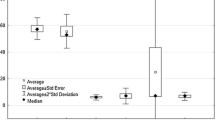Abstract
A sporeling culture method using gametophyte clones developed in the early 1990s led to egg discharge occurring in the dark 5 min after the start of the dark period under growth under a 11:13 L-D photoperiod. The course of egg discharge could be disturbed by light, with irradiance as low as 5–6 μmol photon m−2 s−1 causing 75–80% of the discharged eggs to detach from the oogonia and consequently to die within several hours. In order to enhance outgrowth rate of young sporophytes, a study was conducted to test the effect of controlling darkness in the period 2–3 h after dusk. When the slides were transferred from the standard 11:13 L-D regime to continuous light, eggs were discharged 5 min after the end of the light phase and peaked 5–l5 min later on first day after transfer, indicating that the female gametes “remember” the light-dark regime. This suggests the existence of an endogenous circadian rhythm. During the second and third days, very few eggs were discharged throughout the 11 h of the normal light phase of the L-D regime, indicating the inhibitory effect of continuous light and that the rhtyhm is easily damped by light.
Similar content being viewed by others
References
Li D, Liu H, Peng G, Wu C (1998) Application of gametophyte clones of Japanese strain Undaria pinnatifida to large scale sporeling production. Mar. Sci. 5: 4–5 (in Chinese).
Lüning K (1981) Egg release in gametophytes of Laminaria saccharina induction by darkness and inhibition by blue light and U.V. Br. Phycol. J. 16: 379–393.
Pang S, Hu X, Wu C, Hirosawa A, Ohno M (1997) Intraspecific crossing of Unidaria pinnatifida (Harv.) Sur. –A possible time-saving way of strain selection. Chinese J. Oceanol Limnol 15(3): 227–235.
Pang S, Wu C (1996) Study on gametophyte vegetative growth of Unidaria pinnatifida and its application. Chinese J Oceanol Limnol 14(3): 205–210.
Provasoli L. (1968) Media and prospect for the cultivation of marine algae. In Watanabe A, Hattori A (eds), Cultures and Collection of Algae. Proceedings of the U.S.- Japan Conference. Hakone, Japanese Society of Plant Physiology 63–75.
Wu C (1998) Seaweed resources of China. In Critchley A, Ohno M (eds), Seaweed Resources of the World. Jap. Inter. Cooperation Agency, Yokosuka, Japan, pp. 34–46.
Wu C, Gao N, Cheng D, Chou B, Cai P, Dong S, Wen Z, Cong R (1979) On the malformation disease of Laminaria sporelings. Oceano. et Limnol. Sinica. 10(3): 238–253, (in Chinese).
Wu C, Pang S (1994) On the cultivation of Undaria gametophyte clones and its use in sporeling raising. In Wang S (ed.), Seaweed Biotechn. Shanghai Science and Technology Press, Shanghai, China, 112–115, (in Chinese).
Author information
Authors and Affiliations
Corresponding author
Rights and permissions
About this article
Cite this article
Liu, J., Dong, L., Shen, Y. et al. Effect of light period on egg-discharge of gametophyte clones of Undaria pinnatifida (Phaeophyta). J Appl Phycol 16, 519–521 (2004). https://doi.org/10.1007/s10811-004-5560-6
Received:
Revised:
Accepted:
Issue Date:
DOI: https://doi.org/10.1007/s10811-004-5560-6



